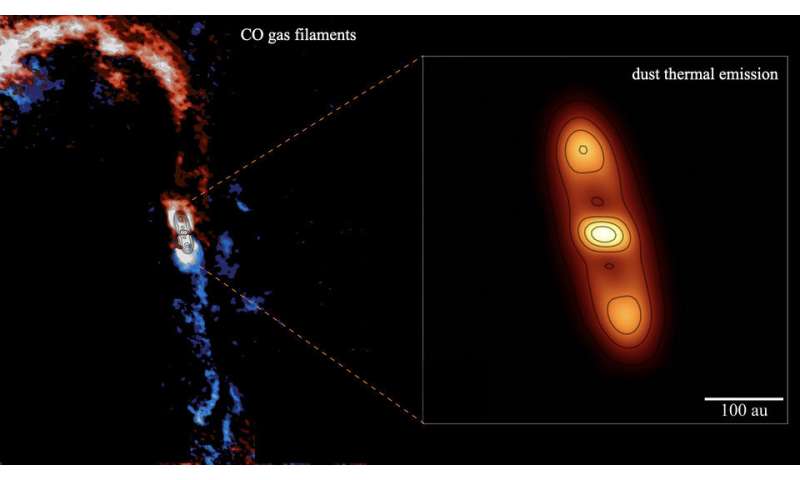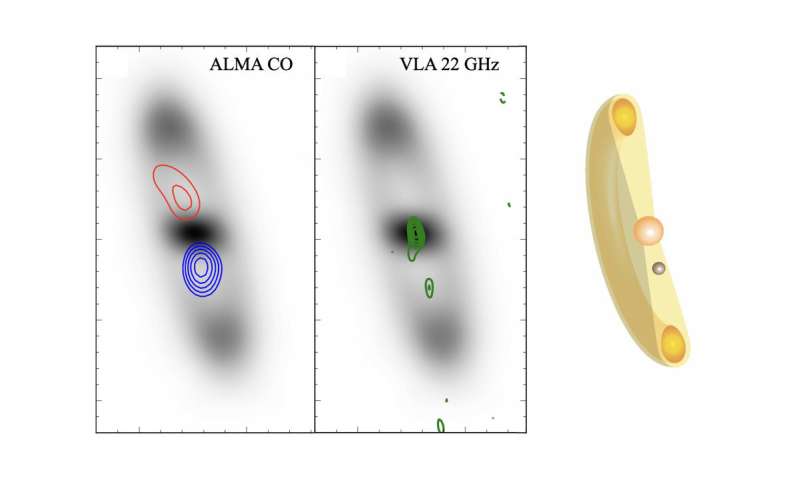A planet-forming disk still fed by the mother cloud
by Max Planck Society

This false-color image shows the filaments of accretion around the protostar [BHB2007] 1. The large structures are inflows of molecular gas (CO) nurturing the disk surrounding the protostar. The inset shows the dust emission from the disk, which is seen edge-on. The "holes" in the dust map represent an enormous ringed cavity seen (sideways) in the disk structure. Credit: MPE
Stellar systems like our own form inside interstellar clouds of gas and dust that collapse producing young stars surrounded by protoplanetary disks. Planets form within these protoplanetary disks, leaving clear gaps, which have been recently observed in evolved systems, at the time when the mother cloud has been cleared out. ALMA has now revealed an evolved protoplanetary disk with a large gap still being fed by the surrounding cloud via large accretion filaments. This shows that accretion of material onto the protoplanetary disk is continuing for times longer than previously thought, affecting the evolution of the future planetary system.
A team of astronomers led by Dr. Felipe Alves from the Center for Astrochemical Studies (CAS) at the Max Planck Institute for Extraterrestrial Physics (MPE) used the Atacama Large Millimeter/submillimeter Array (ALMA) to study the accretion process in the stellar object [BHB2007] 1, a system located at the tip of the Pipe Molecular Cloud. The ALMA data reveal a disk of dust and gas around the protostar, and large filaments of gas around this disk. The scientists interpret these filaments as accretion streamers feeding the disk with material extracted from the ambient cloud.
The disk reprocesses the accreted material, delivering it to the protostar. The structure observed is very unusual for stellar objects at this stage of evolution—with an estimated age of 1,000,000 years—when circumstellar disks are already formed and matured for planet formation. "We were quite surprised to observe such prominent accretion filaments falling into the disk," said Alves. "The accretion filament activity demonstrates that the disk is still growing while simultaneously nurturing the protostar."
The team also reports the presence of an enormous cavity within the disk. The cavity has a width of 70 astronomical units, and it encompasses a compact zone of hot molecular gas. In addition, supplementary data at radio frequencies by the Very Large Array (VLA) point to the existence of non-thermal emission in the same spot where the hot gas was detected. These two lines of evidence indicate that a substellar object—a young giant planet or brown dwarf—is present within the cavity. As this companion accretes material from the disk, it heats up the gas and possibly powers strong ionized winds and/or jets. The team estimates that an object with a mass between 4 and 70 Jupiter masses is needed to produce the observed gap in the disk.
Stellar systems like our own form inside interstellar clouds of gas and dust that collapse producing young stars surrounded by protoplanetary disks. Planets form within these protoplanetary disks, leaving clear gaps, which have been recently observed in evolved systems, at the time when the mother cloud has been cleared out. ALMA has now revealed an evolved protoplanetary disk with a large gap still being fed by the surrounding cloud via large accretion filaments. This shows that accretion of material onto the protoplanetary disk is continuing for times longer than previously thought, affecting the evolution of the future planetary system.
A team of astronomers led by Dr. Felipe Alves from the Center for Astrochemical Studies (CAS) at the Max Planck Institute for Extraterrestrial Physics (MPE) used the Atacama Large Millimeter/submillimeter Array (ALMA) to study the accretion process in the stellar object [BHB2007] 1, a system located at the tip of the Pipe Molecular Cloud. The ALMA data reveal a disk of dust and gas around the protostar, and large filaments of gas around this disk. The scientists interpret these filaments as accretion streamers feeding the disk with material extracted from the ambient cloud.
The disk reprocesses the accreted material, delivering it to the protostar. The structure observed is very unusual for stellar objects at this stage of evolution—with an estimated age of 1,000,000 years—when circumstellar disks are already formed and matured for planet formation. "We were quite surprised to observe such prominent accretion filaments falling into the disk," said Alves. "The accretion filament activity demonstrates that the disk is still growing while simultaneously nurturing the protostar."
The team also reports the presence of an enormous cavity within the disk. The cavity has a width of 70 astronomical units, and it encompasses a compact zone of hot molecular gas. In addition, supplementary data at radio frequencies by the Very Large Array (VLA) point to the existence of non-thermal emission in the same spot where the hot gas was detected. These two lines of evidence indicate that a substellar object—a young giant planet or brown dwarf—is present within the cavity. As this companion accretes material from the disk, it heats up the gas and possibly powers strong ionized winds and/or jets. The team estimates that an object with a mass between 4 and 70 Jupiter masses is needed to produce the observed gap in the disk.

Two different observations of the protoplanetary disk show signatures of the formation of a companion to the protostar . The gray scale represents the dust thermal emission from the disk, same as in the inset of Fig. 1. The red/blue contours show the molecular CO brightness emission levels from the northern/southern side of the dust cavity observed with ALMA. The brighter CO emission from the south indicates that the gas is hotter there. This location coincides with a zone of non-thermal emission tracing ionized gas (green contours) observed with the VLA (middle), which is observed in addition to the protostar (center of the image). The team proposes that both the ionized gas and the hot molecular gas are due to the presence of a protoplanet or a brown dwarf in the cavity. The configuration of such a system is shown in the sketch on the right. Credit: MPE; illustration: Gabriel A. P. Franco
"We present a new case of star and planet formation happening in tandem," states Paola Caselli, director at MPE and head of the CAS group. "Our observations strongly indicate that protoplanetary disks keep accreting material also after planet formation has started. This is important because the fresh material falling onto the disk will affect both the chemical composition of the future planetary system and the dynamical evolution of the whole disk." These observations also put new time constraints for planet formation and disk evolution, shedding light on how stellar systems like our own are sculpted from the original cloud.
Explore further
"We present a new case of star and planet formation happening in tandem," states Paola Caselli, director at MPE and head of the CAS group. "Our observations strongly indicate that protoplanetary disks keep accreting material also after planet formation has started. This is important because the fresh material falling onto the disk will affect both the chemical composition of the future planetary system and the dynamical evolution of the whole disk." These observations also put new time constraints for planet formation and disk evolution, shedding light on how stellar systems like our own are sculpted from the original cloud.
Explore further
More information: Felipe O. Alves et al. A Case of Simultaneous Star and Planet Formation,
The Astrophysical Journal (2020). DOI: 10.3847/2041-8213/abc550
Journal information: Astrophysical Journal
Provided by Max Planck Society
Provided by Max Planck Society
No comments:
Post a Comment